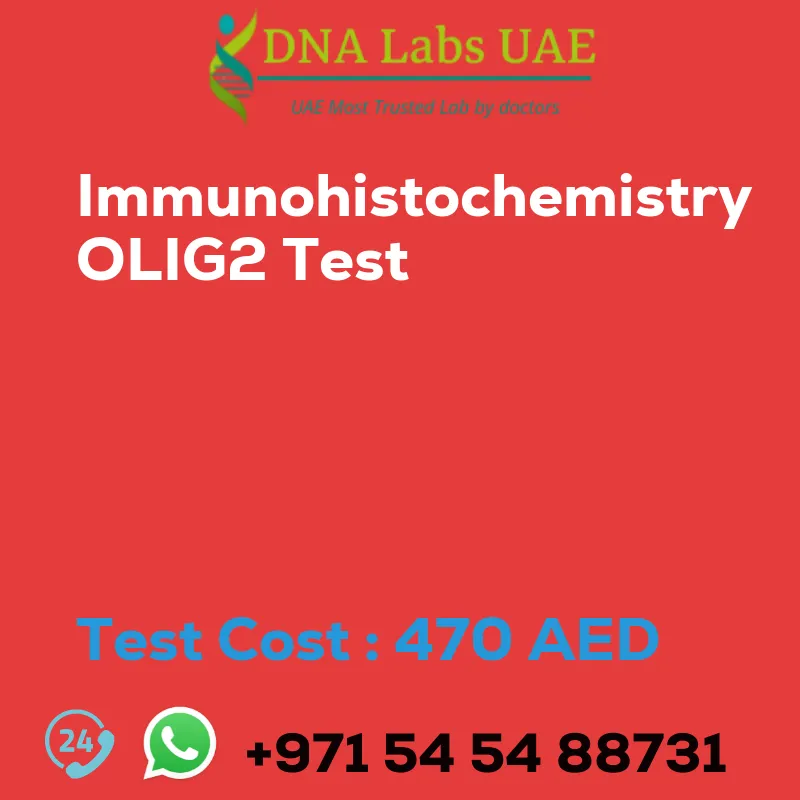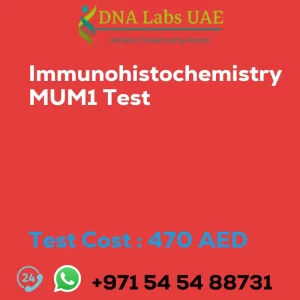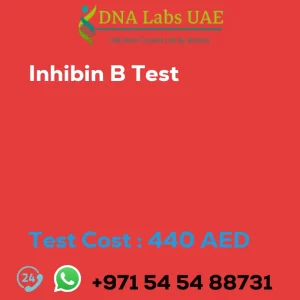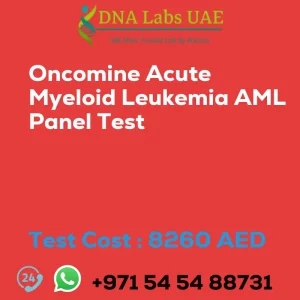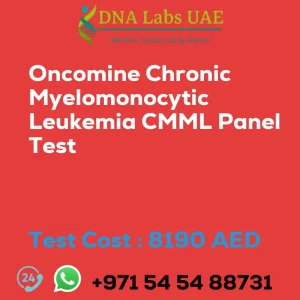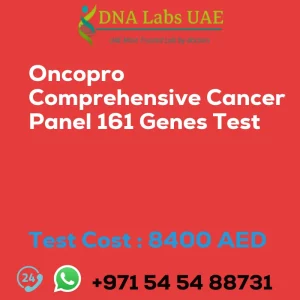IMMUNOHISTOCHEMISTRY OLIG2 Test
Components
Price: 470.0 AED
Sample Condition
Submit tumor tissue in 10% Formal-saline OR Formalin fixed paraffin embedded block. Ship at room temperature. Provide a copy of the Histopathology report, Site of biopsy and Clinical history.
Report Delivery
Sample: Daily by 6 pm
Report Block: 5 days
Tissue Biopsy: 5 days
Tissue large complex: 7 days
Method
Immunohistochemistry
Test type
Cancer
Doctor
Oncologist, Pathologist
Test Department
HISTOLOGY
Pre Test Information
Provide a copy of the Histopathology report, Site of biopsy and Clinical history.
Test Details
Olig2 (Oligodendrocyte transcription factor 2) is a transcription factor that plays a critical role in the development and maintenance of oligodendrocytes, which are the myelin-producing cells in the central nervous system.
Immunohistochemistry (IHC) is a technique used to visualize the presence and localization of specific proteins in tissue samples.
Steps involved in performing an Immunohistochemistry (IHC) Olig2 test:
- Tissue Preparation: Tissue samples are collected and fixed using formalin or other fixatives to preserve the cellular structure and protein integrity.
- Embedding: The fixed tissue is embedded in paraffin wax, which allows for thin sectioning of the tissue for subsequent staining.
- Sectioning: Thin sections (usually around 4-6 micrometers thick) are cut from the paraffin-embedded tissue blocks using a microtome.
- Deparaffinization and Rehydration: The paraffin is removed from the tissue sections using xylene or other clearing agents, followed by rehydration through a series of graded alcohol solutions.
- Antigen Retrieval: Heat-induced antigen retrieval is often performed to unmask the target antigen epitopes that may be masked by the fixation process. This can be achieved by boiling the tissue sections in a citrate buffer or using enzymatic digestion.
- Blocking: Non-specific binding sites are blocked using a blocking solution (e.g., serum or protein-based blocking reagents) to reduce background staining.
- Primary Antibody Incubation: The tissue sections are incubated with a primary antibody specific to Olig2. The primary antibody binds to the Olig2 protein in the tissue sections.
- Secondary Antibody Incubation: After washing off unbound primary antibody, the tissue sections are incubated with a secondary antibody conjugated to a detection system (e.g., horseradish peroxidase or alkaline phosphatase). The secondary antibody binds to the primary antibody.
- Visualization: The detection system catalyzes a colorimetric reaction or produces a fluorescent signal, allowing the visualization of the Olig2 protein in the tissue sections.
- Counterstaining and Mounting: To enhance tissue contrast, counterstaining with dyes such as hematoxylin or eosin may be performed. The stained tissue sections are then mounted onto glass slides using a mounting medium.
- Microscopic Examination: The stained tissue sections are examined under a microscope to assess the presence and localization of Olig2 protein in the tissue.
The results of the Olig2 immunohistochemistry test can provide valuable information about the expression and distribution of Olig2 protein in the tissue sample, which can be useful for studying oligodendrocyte development, myelination, and diseases involving oligodendrocyte dysfunction or loss.
| Test Name | IMMUNOHISTOCHEMISTRY OLIG2 Test |
|---|---|
| Components | |
| Price | 470.0 AED |
| Sample Condition | Submit tumor tissue in 10% Formal-saline OR Formalin fixed paraffin embedded block. Ship at room temperature. Provide a copy of the Histopathology report, Site of biopsy and Clinical history. |
| Report Delivery | Sample Daily by 6 pm; Report Block: 5 days Tissue Biopsy: 5 days Tissue large complex : 7 days |
| Method | Immunohistochemistry |
| Test type | Cancer |
| Doctor | Oncologist, Pathologist |
| Test Department: | HISTOLOGY |
| Pre Test Information | Provide a copy of the Histopathology report, Site of biopsy and Clinical history. |
| Test Details |
Olig2 (Oligodendrocyte transcription factor 2) is a transcription factor that plays a critical role in the development and maintenance of oligodendrocytes, which are the myelin-producing cells in the central nervous system. Immunohistochemistry (IHC) is a technique used to visualize the presence and localization of specific proteins in tissue samples. To perform an immunohistochemistry (IHC) Olig2 test, the following steps are typically involved: 1. Tissue Preparation: Tissue samples are collected and fixed using formalin or other fixatives to preserve the cellular structure and protein integrity. 2. Embedding: The fixed tissue is embedded in paraffin wax, which allows for thin sectioning of the tissue for subsequent staining. 3. Sectioning: Thin sections (usually around 4-6 micrometers thick) are cut from the paraffin-embedded tissue blocks using a microtome. 4. Deparaffinization and Rehydration: The paraffin is removed from the tissue sections using xylene or other clearing agents, followed by rehydration through a series of graded alcohol solutions. 5. Antigen Retrieval: Heat-induced antigen retrieval is often performed to unmask the target antigen epitopes that may be masked by the fixation process. This can be achieved by boiling the tissue sections in a citrate buffer or using enzymatic digestion. 6. Blocking: Non-specific binding sites are blocked using a blocking solution (e.g., serum or protein-based blocking reagents) to reduce background staining. 7. Primary Antibody Incubation: The tissue sections are incubated with a primary antibody specific to Olig2. The primary antibody binds to the Olig2 protein in the tissue sections. 8. Secondary Antibody Incubation: After washing off unbound primary antibody, the tissue sections are incubated with a secondary antibody conjugated to a detection system (e.g., horseradish peroxidase or alkaline phosphatase). The secondary antibody binds to the primary antibody. 9. Visualization: The detection system catalyzes a colorimetric reaction or produces a fluorescent signal, allowing the visualization of the Olig2 protein in the tissue sections. 10. Counterstaining and Mounting: To enhance tissue contrast, counterstaining with dyes such as hematoxylin or eosin may be performed. The stained tissue sections are then mounted onto glass slides using a mounting medium. 11. Microscopic Examination: The stained tissue sections are examined under a microscope to assess the presence and localization of Olig2 protein in the tissue. The results of the Olig2 immunohistochemistry test can provide valuable information about the expression and distribution of Olig2 protein in the tissue sample, which can be useful for studying oligodendrocyte development, myelination, and diseases involving oligodendrocyte dysfunction or loss. |

